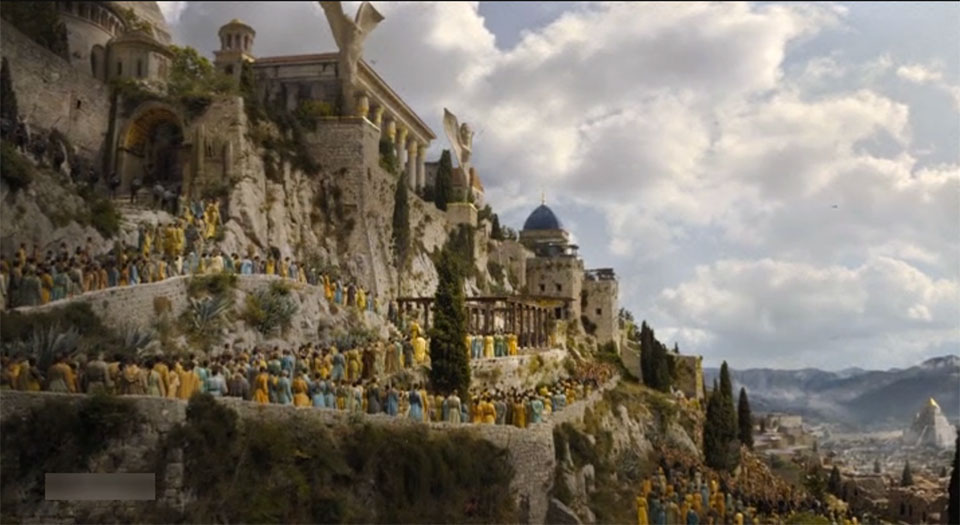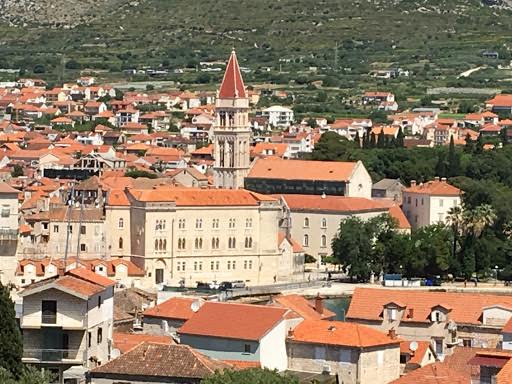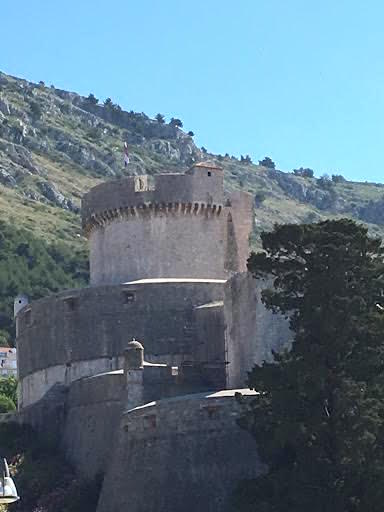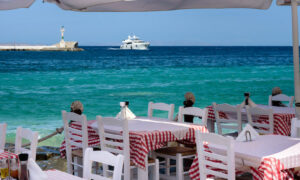(Editor’s note: As “Game of Thrones” wraps up its run as one of the most popular television series of all time, we look back at set-jetter Beth Hoke’s trip to where GoT was filmed in Croatia. Other real countries that have been stand-ins for the Seven Kingdoms include Northern Ireland, Iceland, Malta, Morocco and Spain.)
Hi. My name is Beth and I’m a set-jetter.
You may remember from previous articles of mine that I traveled to Madeira in November because I saw it on The Bachelorette, and when I was recently in London, a pilgrimage to Platform 9 3/4 was a must.
So when my 90 out of 180 days in the Schengen states was up at the end of March, I decided to head to Croatia (a member of the European Union, but not the Schengen area) to see the sites that served as Braavos, Meereen, Qarth, and King’s Landing in the über-popular “Game of Thrones” HBO series.
SET-JETTING

 Set-jetting, a form of tourism that Fo
Set-jetting, a form of tourism that Fo rbes describes as being “motivated by TV or movies,” has been driving Croatia’s economy in recent years.
rbes describes as being “motivated by TV or movies,” has been driving Croatia’s economy in recent years.
The so-called “Game of Thrones effect” has escalated to the point that 18 percent of the country’s GDP comes from tourism according to an article from Lonely Planet.
From the medieval town of Šibenik in the north to historic Dubrovnik in the south, the coast of Croatia has been used extensively in the series.
Šibenik was featured in the fifth season as the city of Braavos, home to the “House of Black and White” or the temple of the Many-Faced God. Standing outside the Cathedral of St. James, a UNESCO World Heritage site, it’s difficult to believe that George R.R. Martin, the author of the books on which the HBO series was based, didn’t have this exact location in mind for the temple.
The cathedral was built entirely from stone over a period of 104 years and is the work of three different architects in a mix of Gothic and Renaissance styles. The feature that makes it perfect for the “House of Black and White” is the frieze made up of 71 faces sculpted by 15th-century stonemason Juraj Dalmatinac, which lines the exterior of the cathedral. (See photos above.)
Across the square from the cathedral is the old town hall with its Renaissance-style columns and arches. The building has been fully restored after being destroyed by the allied forces in December 1943, but no longer houses the government’s offices.
Instead, the street-level is home to a café from which you can sit and people watch while you sip a cup of coffee and take in the detailed stonework on the cathedral.
Up the hill from the town square is a medieval Mediterranean garden on the grounds of the monastery of St. Lawrence where medicinal and seasonal herbs are grown, as well as capers which are said to have been planted by Dalmatinac.
Farther up the hill is St. Michael’s Fortress, with a modern open-air event stage and a panoramic view of the waterway. The shops in the area don’t capitalize on the town’s relationship to the television series, but there is at least one souvenir shop dedicated solely to themed merchandise.
The rest of the shops sell works by local artisans, antiques, books, and the requisite keychains, postcards and T-shirts.
Down along the harbor are a number of restaurants serving traditional Dalmatian dishes and attractions including a small aquarium and a city museum.
On to ‘Qarth’ and Trogir
A little over an hour south of Šibenik by bus is a small town that avid viewers of Game of Thrones would recognize as the trading harbor of Qarth. The “skyline” of Trogir is pierced by the bell tower of the Church of St. Dominic.
On the grounds of a monastery used in scenes from the series, the church houses a small museum filled with religious relics. An even taller bell tower belongs to the Cathedral of St. Lawrence, which one can enter through Radovan’s portal, a highly detailed example of Romanesque sculpture featuring scenes from the life of Christ.
Other notable sites in Trogir include the central loggia; the clock tower of the Church of St. Sebastian; and the Kamerlengo Castle, which once served as a fortress to defend the Venetian army fleet and now offers tourists a 360-degree view of the town.
As in Šibenik, the restaurants along the harbor offer traditional Dalmatian specialties, and the winding, cobblestoned streets are full of small shops featuring artwork, handcrafted jewelry, and everyday souvenirs. A farmer’s market is set up every day of the week across from the bus station. Vendors sell beautiful flower bouquets, homegrown produce, and still more souvenirs.
Trogir’s bus station is surprisingly busy, with frequent departures for local destinations like the nearby island of Čiovo and Split’s tiny airport, longer regional trips across Croatia, and long-distance journeys to other European countries.
SPLIT
 Three times an hour throughout the day and long into the night, a local bus will take you to Split, where you can walk to the harbor and into the historic city center.
Three times an hour throughout the day and long into the night, a local bus will take you to Split, where you can walk to the harbor and into the historic city center.
Split has a more prominent role in Game of Thrones than either Šibenik or Trogir. Diocletian’s Palace, a — you guessed it —UNESCO World Heritage site, was built by the Roman emperor in the 3rd century.
Built from local limestone and white marble, the palace complex is now a beautifully preserved relic from the Diocletian era.
Standing in the streets inside the palace walls, you can easily call to mind the scenes in “Game of Throne”s in which Daenarys and her army free the slaves of Meereen in an epic revolt.
Fans of the series will also recognize Daenarys’s throne room in the basement of the palace as well as the location where Ser Barristan is killed by the Sons of the Harpy in the fifth season.
Even in Split, the connection to the series is not played up for tourists. That is not to say that you can’t find a Game of Thrones-inspired tchotchke if you really must have one, or hear the occasional strain of the theme song.
But other than a few Game of Thrones tours offered by local guides, the fact that Split is one of the filming locations isn’t overly evident.
Ok, I’ve saved the best for last.
DUBROVNIK
Dubrovnik is the mecca for Game of Thrones fans in Croatia.
It takes between 4 hours and 5-1/2 hours from Split to get there (depending on traffic, construction, and whether or not your bus driver needs to stop for a beer along the way).
But it is worth the trip, not only for the spectacular coastal scenery but for the overwhelming feeling of being plucked out of modern times and dropped right into the middle of a city that can only be described as the embodiment of King’s Landing.
Dubrovnik’s roots as a center for maritime trade made it the ideal site for the capital of the Seven Kingdoms and the epic battle that took place in Blackwater Bay in season two.
This well-preserved walled city is — say it with me now — a UNESCO World Heritage site.
As fangirls, my daughters, my cousin’s niece, and I had to walk the city walls.
For a fee (expert tip: there are lower rates for students who carry an EU student card and those under 18), you can walk the uninterrupted 1.2 miles of wall that surround the city.
A WALK NOT FOR THE WEAK
After climbing a steep flight of stairs to get to the wall itself, there is no exit until you have completed the circuit.
Though 1.2 miles doesn’t seem that long, trust me, it feels longer in the midday sun.
Someone was being kind when they put several small restaurants and gelato stands in shaded nooks along the way.
If you want to break the walk into smaller chunks and get out of the sun for a while, it is possible.
After climbing the stairs to the top of the wall, one of the first things you notice is Fort Lovrijenac, or The Fort of St. Lawrence, the “body double” for the Red Keep, where the tournament on King Joffrey’s name day is held.
From this vantage point, you can also see Fort Bokar, which was first used in shots of King’s Landing in season two.
From every point along the wall, you can see the dark blue waters of the Adriatic Sea.
The view of the sea alone is worth the trip to the top of the wall. Continuing on to the opposite side of the walls, you can see across a mass of terra-cotta rooftops. Until you reach this point, it is difficult to grasp the true size of the city.
Near the end of the city walls is Minčeta Tower, the highest point in the city of Dubrovnik and the symbol of the Republic. The base of the circular stone tower is the setting for the scene in which Daenarys is trying to find the entrance to the House of the Undying in Qarth.
So far, the city’s limestone walls have withstood sieges, an earthquake, and an onslaught of tourism.
Within the city walls are other iconic sites featured in the series, including: the Jesuit Staircase where Cersei took her walk of shame; St. Dominic Street, which is used for the market scenes in King’s Landing; the Ethnographic Museum, otherwise known as Littlefinger’s brothel; and the Rector’s Palace, or the residence of the Spice King of Qarth.
LOKRUM ISLAND
If Qarth is more to your taste, or if you want to sit in the actual Iron Throne (donated by the series), you can take a ferry 600 meters across the bay to Lokrum Island.
Inside one of the remaining wings of a Benedictine monastery is a small (free!) Game of Thrones museum and the Iron Throne itself. Outside the monastery, visitors will recognize the setting of the garden scenes in Qarth.
Miraculously, this island paradise has yet to become overwhelmed by tourists. Not only does it serve as a peaceful respite from the hustle and bustle of Dubrovnik, it has a resort-like feeling with recreational opportunities in the form of sports fields, swimming areas, and a nature reserve where peacocks wander free.
Honestly, if I were to go back to any one of the places we visited during our epic Game of Thrones adventure, it would be Lokrum Island.
Despite all that we were able to see in our week-long “Games of Thrones” journey, there are still so many more filming locations that we couldn’t fit into our trip. And that’s only Croatia.
There’s still Northern Ireland, Malta, Iceland, Spain, and Morocco.
Be right back: I have tickets to book.

BETH
About the author:
Beth Hoke rejoined the expat life after spending her childhood in Europe and the United States, then settling in Chicagoland to raise two daughters.
Now an empty nester, she is roaming Europe, armed with a TEFL certificate and an online position teaching English for EF.
Beth has been traveling around Europe for two years. She’s filed posts for Dispatches Europe from at least six countries including Italy, Germany, Croatia, and Madeira, Portugal.



















